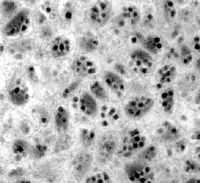
Implication for DNA methylation involved in the host transfer of diamondback moth, Plutella xylostella (L.).
Sign Up to like & getrecommendations! Published in 2019 at "Archives of insect biochemistry and physiology"
DOI: 10.1002/arch.21600
Abstract: DNA methylation exerts extensive impacts on gene expression of various living organisms exposed to environmental variation. However, little is known whether DNA methylation is involved in the host transfer of diamondback moth, Plutella xylostella (L.),… read more here.
Keywords: xylostella; methylation; dna methylation; host transfer ... See more keywords

Comparative analysis of dsRNA-induced lncRNAs in three kinds of insect species.
Sign Up to like & getrecommendations! Published in 2019 at "Archives of insect biochemistry and physiology"
DOI: 10.1002/arch.21640
Abstract: Long noncoding RNAs (lncRNAs) that have immune responses to various stimuli have been identified in some insects. One type of pathogen-associated molecular pattern, double-stranded RNA (dsRNA), can trigger the RNA interference (RNAi) pathway and immune… read more here.
Keywords: xylostella; insects; insect species; induced lncrnas ... See more keywords

Fitness comparison of Plutella xylostella on original and marginal hosts using age‐stage, two‐sex life tables
Sign Up to like & getrecommendations! Published in 2021 at "Ecology and Evolution"
DOI: 10.1002/ece3.7804
Abstract: Abstract The diamondback moth, Plutella xylostella, is an important agricultural pest that severely damages cruciferous vegetables. Although previously considered a threat only to Brassica species, P. xylostella has been observed to feed on noncruciferous vegetables.… read more here.
Keywords: xylostella; pea; life; rate ... See more keywords

Over-expression of UDP-glycosyltransferase gene UGT2B17 is involved in chlorantraniliprole resistance in Plutella xylostella (L.).
Sign Up to like & getrecommendations! Published in 2017 at "Pest management science"
DOI: 10.1002/ps.4469
Abstract: BACKGROUND UDP-glycosyltransferases (UGTs) are phase II detoxification enzymes widely distributed within living organisms. Their involvement in the biotransformation of various lipophilic endogenous compounds and phytoalexins in insects has been documented. However, the roles of this… read more here.
Keywords: xylostella; chlorantraniliprole resistance; expression; resistance ... See more keywords

Identification and RNAi-based function analysis of chitinase family genes in diamondback moth, Plutella xylostella.
Sign Up to like & getrecommendations! Published in 2019 at "Pest management science"
DOI: 10.1002/ps.5308
Abstract: BACKGROUND Insect chitinases play a vital part in chitin degradation in exoskeletons and gut linings during the molting process, and therefore are considered potential targets for new insecticide designs or RNA interference (RNAi)-based pest management.… read more here.
Keywords: xylostella; rnai based; analysis chitinase; chitinase ... See more keywords

The antifeedant, insecticidal and insect growth inhibitory activities of triterpenoid saponins from Clematis aethusifolia Turcz against Plutella xylostella (L.).
Sign Up to like & getrecommendations! Published in 2020 at "Pest management science"
DOI: 10.1002/ps.6038
Abstract: BACKGROUND The diamondback moth, Plutella xylostella (L.) (Lepidoptera: Plutellidae), is a global insect pest of crops, leading to a reduction of agricultural products in productivity and quality. Plant saponins are rich sources for the discovery… read more here.
Keywords: xylostella; triterpenoid saponins; growth inhibitory; antifeedant insecticidal ... See more keywords

Immunotranscriptome analysis of Plutella xylostella reveals differences in innate immune responses to low- and high-virulence Beauveria bassiana strain challenges.
Sign Up to like & getrecommendations! Published in 2020 at "Pest management science"
DOI: 10.1002/ps.6124
Abstract: BACKGROUND Entomopathogenic fungi have developed multiple strategies to overcome the immune defenses of their target insects, whereas insect pests have devised various defense mechanisms to combat fungal infection. However, differences in the molecular mechanisms of… read more here.
Keywords: xylostella; virulence; plutella xylostella; beauveria bassiana ... See more keywords

Silencing β-1, 3-glucan binding protein enhances the susceptibility of Plutella xylostella to entomopathogenic fungus Isaria cicadae.
Sign Up to like & getrecommendations! Published in 2022 at "Pest management science"
DOI: 10.1002/ps.6938
Abstract: BACKGROUND The diamondback moth, Plutella xylostella is a notorious pest of brassicaceae crops globally and has developed serious resistance to insecticide. Insects primarily rely on their innate immunity to defense against various pathogens. In this… read more here.
Keywords: plutella xylostella; xylostella; glucan binding; binding protein ... See more keywords

Environment polluting conventional chemical control compared to an environmentally friendly IPM approach for control of diamondback moth, Plutella xylostella (L.), in China: a review
Sign Up to like & getrecommendations! Published in 2017 at "Environmental Science and Pollution Research"
DOI: 10.1007/s11356-017-8996-3
Abstract: The diamondback moth, Plutella xylostella, is recognized as a widely distributed destructive insect pest of Brassica worldwide. The management of this pest is a serious issue, and an estimated annual cost of its management has… read more here.
Keywords: xylostella; ipm approach; control; chemical control ... See more keywords

Canola cultivars affect nutrition and cold hardiness of Plutella xylostella (L.) (Lepidoptera: Plutellidae)
Sign Up to like & getrecommendations! Published in 2020 at "International Journal of Tropical Insect Science"
DOI: 10.1007/s42690-020-00125-8
Abstract: The diamondback moth, Plutella xylostella (L.), has become the most destructive insect pest of Brassica crop plants, such as B. napus throughout the world including Iran. In this study, nutritional indices, digestive enzyme activity and… read more here.
Keywords: xylostella; cold hardiness; canola cultivars; plutella xylostella ... See more keywords

Bottom-up effects of Brassica genotypes on performance of diamondback moth, Plutella xylostella (Lepidoptera: Plutellidae)
Sign Up to like & getrecommendations! Published in 2019 at "Crop Protection"
DOI: 10.1016/j.cropro.2018.09.020
Abstract: Abstract The adverse effects of excessive application of insecticides is causing a renewed interest to find resistant host plants to insect pest. Herein, we attempted to elucidate the bottom-up effects of five canola cultivars (Elite,… read more here.
Keywords: bottom effects; xylostella; plutella xylostella; red rocky ... See more keywords